Open dynamic allocation and flexible priorities
When working with your managed inventory, you often have eligible demand from a number of different channels. You might have managed demand that you have sold on a guaranteed or up-front basis, which you need to ensure meets delivery commitments. You might also have managed demand that your team is responsible for trafficking, but that may not have committed up-front guarantees (performance demand, house campaigns, etc.). And finally, you might have external demand sources that you work with by exposing your inventory for reselling on the Microsoft Advertising exchange.
Through Open Dynamic Allocation, Microsoft Monetize allows you to optimize across these different demand channels: maximizing revenue for your managed inventory while still ensuring delivery in full for your guaranteed/high-priority managed demand.
In this document, we explain the controls you have at your disposal to configure Open Dynamic Allocation so you can tune, to your preference, how the system decisions between maximizing revenue and mitigating risk to delivery. We also explain in detail how flexible line item priorities affect how these different demand sources are allowed to compete.
Flexible priorities provide control for managing demand
You can set priority on both standard and guaranteed delivery line items to any value from 1 through 20.
Historically, standard line items have been restricted to lower priority settings than guaranteed delivery line items. This ensured that eligible guaranteed line items would always deliver before standard line items. In most cases this is the desired behavior: we need guaranteed line items to always deliver in full, so prioritizing them above standard line items is one logical way of making that happen. However, there are cases where, due to various customer commitments, it is important that standard line items be prioritized at or even above line items with guaranteed delivery goals.
For more information on setting priorities, see Create a Standard Line Item and Create a Guaranteed Delivery Line Item.
The impact of flexible priorities on open dynamic allocation
The ability to set line items of any type to any priority (1-20) changes the dynamics of bid submissions. There are three factors relating to priority that determine how demand will compete:
- Reselling priority: This is a value that is set at the Network (member) level. Reselling priority governs when inventory is available for resale to RTB demand. When a line item from a managed advertiser has a priority value at or above reselling priority and is eligible for an impression, then the impression is not available to RTB buyers. (See Managing Your Inventory Reselling Exposure for more information.) This value also impacts guaranteed line items. The system will identify the highest priority guaranteed bid and highest priority standard bid. If the highest of these two priorities is:
- below the reselling priority, then we allow both the guaranteed demand from the highest guaranteed priority tier and the standard demand from the highest standard priority tier to compete in the auction.
- at or above the reselling priority, then we allow only demand from that higher tier to compete in the auction.
- Standard line item priority: The priority assigned to the standardline item. The default value is 5.
- Guaranteed delivery line item priority: The priority assigned to the guaranteed delivery line item. The default value is 14 for "Impressions" and 19 for "Exclusive".
The following scenarios illustrate how the three settings above interact to determine how demand is allowed to compete in the auction.
Example scenarios demonstrating flexible priorities
These scenarios assume targeting is met for all line items in question. Other settings, such as targeting, also impact which line items are submitted.
Note
Under all these scenarios, if there is an eligible guaranteed delivery line item with:
- a delivery type of Exclusive and
- a priority greater than or equal to all other line items
that line item will be the only one selected and will win the impression.
Scenario 1
In this first scenario, we have three guaranteed delivery line items, all with priority set at 12. We also have three standard line items: two with priority 10, one with priority 9. All of these line items have priorities above the reselling priority of 6, so they will not compete against RTB demand. Instead, the highest priority line items from each tier (guaranteed and standard) will be determined. The line item with the highest priority will be sent to auction. If a guaranteed delivery line item has the highest priority, only one line item will be sent. (This is the case even if there are multiple guaranteed line items with that same priority. See Guaranteed Delivery Auction Mechanics for details on how the guaranteed delivery line item is selected.) If a standard line item has a higher priority than the highest priority guaranteed line item, only the standard line item will be sent to auction. (If multiple standard line items have the same, highest, priority, all of them will be sent to auction.)
In this scenario, one of the priority 12 guaranteed delivery line items will be sent, because it's set to a higher priority than any of the standard line items.
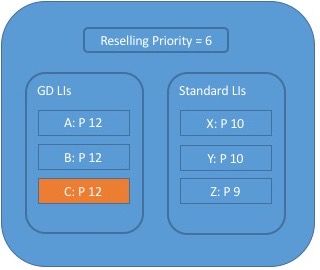
Scenario 2
In this scenario we have three guaranteed delivery line items, two with a priority of 16, one with priority 10. We also have three standard line items: two at priority 16, one at priority 5. We determine the highest priority from each tier; in this case that's priority 16 for both guaranteed and standard line items. As in Scenario 1, the highest line item priority (16) is higher than the reselling priority (6), so we don't compete against RTB. Unlike the first scenario, we have standard line items that are at the same priority as the highest guaranteed line item. So for guaranteed delivery, we select one of the line items at priority 16. We also select both priority 16 standard line items, and send all three to compete in the auction.
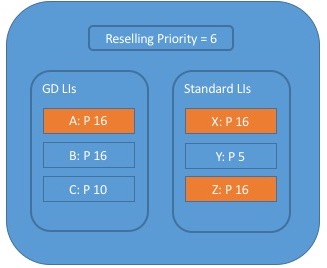
Scenario 3
In this final scenario, the reselling priority is higher than the highest line item priority. When that happens, all line items compete against RTB. In addition, we always send one guaranteed delivery line item with the highest priority in that tier, as well as all standard line items with the highest priority among the standard line items. The following examples demonstrate different possibilities in this scenario:
Example 1: One guaranteed delivery line item at priority 12 and all priority 12 standard line items are submitted to auction to compete with RTB.
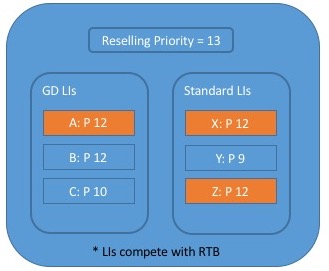
Example 2: One guaranteed delivery line item at priority 10 and all priority 12 standard line items are submitted to auction to compete with RTB.
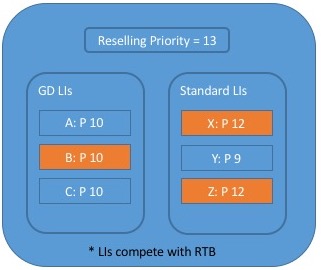
Example 3: One guaranteed delivery line item at priority 12 and all priority 10 standard line items are submitted to auction to compete with RTB.
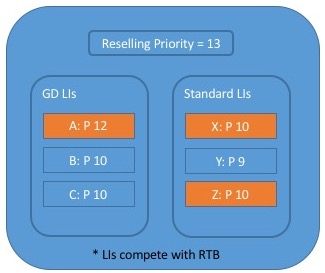
Implementation recommendations
Reselling priority: We recommend that you set Reselling priority 1 tier higher than your lowest priority tier used for guaranteed demand.
Guaranteed Line Item Priorities: The lowest priority tier you decide to use for guaranteed demand will be allowing guaranteed demand to compete with other demand channels, which gives the system the best ability to maximize your revenue. Because of this, you should aim to have as much of your guaranteed demand set up at this tier as possible. Priorities at and above reselling priority can then be used to exempt certain guaranteed line items from competition. Examples for why you would want to exempt demand from competition (which risks lower overall revenue to protect delivery) include:
- A line item is part of an insertion order for a sensitive client relationship, and it's worth the impact to overall revenue to ensure the line item meets its goals.
- You know inventory availability is scarce for a line item, so you prioritize it at or above reselling priority to give it the best chance of delivering in full.
Standard Line Item Priorities: Standard line items are generally prioritized below guaranteed line items. Avoid spreading standard line items across many priority tiers, as this adversely affects yield. Similar to how most guaranteed demand is set up on a single tier, so should most standard lines be set up on a single priority tier. Example for why you would want to prioritize certain standard line items over others include:
You want to ensure that important performance demand is given preference over mediated demand.
You want to traffic house ads at a lower priority, as it is difficult to determine a CPM value for these line items.
Note
The mechanics behind guaranteed delivery continue to work to help ensure that you reach your delivery goals, even when competing against standard line items. See Guaranteed Delivery Auction Mechanics.